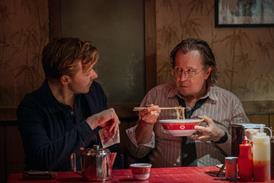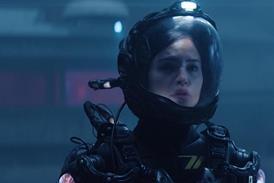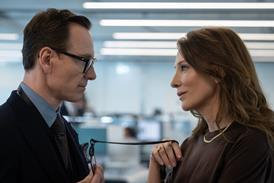Dir: David Fincher. US. 2002. 113mins
David Fincher is such a technically inventive and brilliant director that, even when he tackles a genre film, like his new suspense feature The Panic Room, he elevates it with his signature flourishes way above its damsel-in-distress origins. Recalling noir films about women trapped in a confined space, David Koepp's functional script centres on a single mother and her sickly daughter whose new house is invaded by a bunch of greedy burglars. Panic Room heralds a commercial comeback for Jodie Foster, who gives a wonderfully commanding performance after bad career choices such as Anna And The King. While almost carrying the entire film, Foster does receive notable assistance from the actors who play the intruders, Forest Whitaker, Dwight Yoakam, and Jared Leto. The slick and enticing trailers and TV ads should help this Columbia spring release become a winner at the US box office when it opens this weekend, with the kind of inter-generational plot that easily crosses demographic groups. Prospects in foreign territories and ancillary markets are also strong for an enjoyable, often nail-biting, picture.
At first sight, the script appears to draw most of its juicy force from a sure-win proven formula: a woman alone in the dark, here with an unstable daughter in her early teens, forced to use all of her limited resources to protect their lives. It's a premise that has worked for, among others, Rosalind Russell in the Oscar-nominated Night Must Fall; Barbara Stanwyck in Sorry, Wrong Number; Audrey Hepburn in her last Oscar-nominated performance, Wait Until Dark; and Catherine Deneuve in Repulsion.
But while most of the aforementioned titles are based on stage plays that betray their origins, Panic Room benefits from being written directly for the big-screen. As such it receives a highly cinematic treatment from a director who rises to the occasion and makes the most out of the inherent restrictions of both source material and space.
Like most thrillers, Panic Room begins in a quiet, if ominous mood, when Meg Altman (Foster), a newly divorced mother, and her young daughter Sarah (Stewart), move into a luxurious Manhattan brownstone. It's quickly established that a previous owner, an eccentric millionaire, has built a hidden chamber (the panic room) to protect himself and his money in the event of a break-in. The sanctuary contains eight video monitors linked to cameras throughout the house, a nod by Fincher to Hitchcock's Rear Window. The room also has stashes of emergency supplies such as water and fire blankets.
The irony is that Meg and her daughter are unaware of how soon they will need to use the facility. Screenwriter Koepp provides enough details in the first reel to suggest that neither woman is technically adept, and that the state-of-the-art alarm system is bafflingly sophisticated, even for more clued-up users.
The action begins when three men stage a seamless late night break-in. Following the genre's conventions, perhaps to the point of cliche, the intrusion occurs during a rainstorm, cutting off contact with the outside world. Most of the story depicts the women trapped in their panic room, although Koepp offers a number of opportunities for Meg to get out of the room. Later in the film the roles are reversed, as Meg finds herself outside the room with the burglars trapped inside.
Fincher's film touches a timely chord with its concept of a panic room, a sanctuary that dates back to medieval times and the concept of a castle keep. Then, in the 20th century, it gave way to bomb shelters that later evolved into storm shelters. Contemporary audiences, especially American ones, will relate to this notion: much publicity has been given to the security of top US officials during the September 11 terrorists attacks and the unknown whereabouts of the president and vice president during the early hours of the crisis.
But even before September 11, audiences worldwide could relate to the issues of terrorism and kidnapping and the sense of fear and paranoia that develop when these take place in restricted areas such as airplanes. Needless to say, at present, there's even more insecurity and paranoia.
Some humour and bickering are offered through the differences between the three burglars. However, with the exception of the morally conflicted and more sensitive Burnham (Whitaker), the other trespassers lack in-depth characterisation and serve mostly as plot points. It's a description that also applies to Meg's ex-husband, Stephen (Bauchau), who arrives in the midst of the crisis, but is immediately beaten and rendered dysfunctional by the burglars.
In this, and other respects, Panic Room is only a notch or two above a routine thriller. Overall, however, the shapely narrative assumes the structure of a deadly cat-and-mouse game, with just enough twists and turns to distinguish it from the overly familiar genre. In Panic Room, just as in his previous efforts such as Seven, The Game and Fight Club, Fincher shows his penchant for macabre and sinister games, both literally and metaphorically. If Panic Room lacks the clean and coherent look of Fincher's other films, it's probably because his regular cinematographer, the gifted Darius Khondji, departed during the shoot due to alleged creative differences and was replaced by Conrad W Hall.
Panic Room is an addition to Foster's string of keynote roles in which she displays a special penchant for playing outsiders and borderline losers (The Silence Of The Lambs) who hold onto their will and integrity against all the odds. Even when Foster has played victims, such as in her first Oscar-winning role, The Accused, she has come across as a more active and complex victim.
One of her generation's greatest, most revelatory and complex actresses, Foster gives a dominant performance that easily overcomes many of the script's problems. Replacing Nicole Kidman at the last minute (after she injured her knee on Moulin Rouge), Foster renders a matter-of-fact, non-nonsense performance that draws on her physical and mental strength. This is a double achievement, considering that the actress was in advance stages of pregnancy at the time of the shoot.
Pro co: A Sony Pictures Entertainment release of a Columbia Pictures presentation of a Hofflund/Polone production of an Indelible Picture
US dist: Sony Pictures
Int'l dist: Colombia TriStar
Prods: Gavin Polone, Judy Offlund, David Koepp, Cean Chaffin
Scr: David Koepp
Cinematography: Conrad W. Hall, Darius Khondji
Prod des: Arthur Max
Eds: James Haygood, Angus Wall
Music: Howard Shore
Main cast: Jodie Foster, Forest Whitaker, Dwight Yoakam, Jared Leto, Kristen Stewart, Patrick Bauchau



















No comments yet